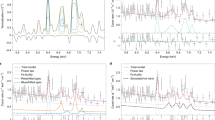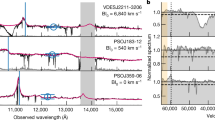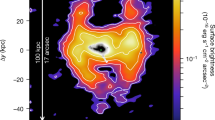Abstract
Powerful winds driven by active galactic nuclei are often thought to affect the evolution of both supermassive black holes and their host galaxies, quenching star formation and explaining the close relationship between black holes and galaxies1,2. Recent observations of large-scale molecular outflows3,4,5,6,7,8 in ultraluminous infrared galaxies support this quasar-feedback idea, because they directly trace the gas from which stars form. Theoretical models9,10,11,12 suggest that these outflows originate as energy-conserving flows driven by fast accretion-disk winds. Proposed connections between large-scale molecular outflows and accretion-disk activity in ultraluminous galaxies were incomplete3,4,5,6,7,8 because no accretion-disk wind had been detected. Conversely, studies of powerful accretion-disk winds have until now focused only on X-ray observations of local Seyfert galaxies13,14 and a few higher-redshift quasars15,16,17,18,19. Here we report observations of a powerful accretion-disk wind with a mildly relativistic velocity (a quarter that of light) in the X-ray spectrum of IRAS F11119+3257, a nearby (redshift 0.189) optically classified type 1 ultraluminous infrared galaxy hosting a powerful molecular outflow6. The active galactic nucleus is responsible for about 80 per cent of the emission, with a quasar-like luminosity6 of 1.5 × 1046 ergs per second. The energetics of these two types of wide-angle outflows is consistent with the energy-conserving mechanism9,10,11,12 that is the basis of the quasar feedback1 in active galactic nuclei that lack powerful radio jets (such jets are an alternative way to drive molecular outflows).
This is a preview of subscription content, access via your institution
Access options
Subscribe to this journal
Receive 51 print issues and online access
$199.00 per year
only $3.90 per issue
Buy this article
- Purchase on Springer Link
- Instant access to full article PDF
Prices may be subject to local taxes which are calculated during checkout



Similar content being viewed by others
References
Fabian, A. Observational evidence of active galactic nuclei feedback. Annu. Rev. Astron. Astrophys. 50, 455–489 (2012)
Veilleux, S., Cecil, G. & Bland-Hawthorn, J. Galactic winds. Annu. Rev. Astron. Astrophys. 43, 769–826 (2005)
Fischer, J. et al. Herschel-PACS spectroscopic diagnostics of local ULIRGs: conditions and kinematics in Markarian 231. Astron. Astrophys. 518, L41 (2010)
Feruglio, C. et al. Quasar feedback revealed by giant molecular outflows. Astron. Astrophys. 518, L155 (2010)
Sturm, E. et al. Massive molecular outflows and negative feedback in ULIRGs observed by Herschel-PACS. Astrophys. J. 733, L16 (2011)
Veilleux, S. et al. Fast molecular outflows in luminous galaxy mergers: evidence for quasar feedback from Herschel. Astrophys. J. 776, 27 (2013)
González-Alfonso, E. et al. The Mrk 231 molecular outflow as seen in OH. Astron. Astrophys. 561, A27 (2014)
Cicone, C. et al. Massive molecular outflows and evidence for AGN feedback from CO observations. Astron. Astrophys. 562, A21 (2014)
Zubovas, K. & King, A. Clearing out a galaxy. Astrophys. J. 745, L34 (2012)
Faucher-Giguère, C.-A. & Quataert, E. The physics of galactic winds driven by active galactic nuclei. Mon. Not. R. Astron. Soc. 425, 605–622 (2012)
Zubovas, K. & Nayakshin, S. Energy- and momentum-conserving AGN feedback outflows. Mon. Not. R. Astron. Soc. 440, 2625–2635 (2014)
Wagner, A. Y., Umemura, M. & Bicknell, G. V. Ultrafast outflows: galaxy-scale active galactic nucleus feedback. Astrophys. J. 763, L18 (2013)
Tombesi, F. et al. Evidence for ultra-fast outflows in radio-quiet AGNs. I. Detection and statistical incidence of Fe K-shell absorption lines. Astron. Astrophys. 521, A57 (2010)
Gofford, J. et al. The Suzaku view of highly ionized outflows in AGN.—I. Statistical detection and global absorber properties. Mon. Not. R. Astron. Soc. 430, 60–80 (2013)
Chartas, G., Saez, C., Brandt, W. N., Giustini, M. & Garmire, G. P. Confirmation of and variable energy injection by a near-relativistic outflow in APM 08279+5255. Astrophys. J. 706, 644–656 (2009)
Pounds, K. A. & Reeves, J. N. Quantifying the fast outflow in the luminous Seyfert galaxy PG1211+143. Mon. Not. R. Astron. Soc. 397, 249–257 (2009)
Lanzuisi, G. et al. HS 1700+6416: the first high-redshift unlensed narrow absorption line-QSO showing variable high-velocity outflows. Astron. Astrophys. 544, A2 (2012)
Chartas, G. et al. Magnified views of the ultrafast outflow of the z = 1.51 active galactic nucleus HS 0810+2554. Astrophys. J. 783, 57 (2014)
Gofford, J. et al. Revealing the location and structure of the accretion disk wind in PDS 456. Astrophys. J. 784, 77 (2014)
Kawakatu, N., Imanishi, M. & Nagao, T. Anticorrelation between the mass of a supermassive black hole and the mass accretion rate in type 1 ultraluminous infrared galaxies and nearby QSOs. Astrophys. J. 661, 660–671 (2007)
Teng, S. H. & Veilleux, S. X-QUEST: a comprehensive x-ray study of local ULIRGS and QSOs. Astrophys. J. 725, 1848–1876 (2010)
King, A. R. & Pounds, K. A. Black hole winds. Mon. Not. R. Astron. Soc. 345, 657–659 (2003)
Reynolds, C. S. Constraints on Compton-thick winds from black hole accretion disks: can we see the inner disk? Astrophys. J. 759, L15 (2012)
Hopkins, P. F. & Elvis, M. Quasar feedback: more bang for your buck. Mon. Not. R. Astron. Soc. 401, 7–14 (2010)
Miniutti, G. & Fabian, A. C. A light bending model for the X-ray temporal and spectral properties of accreting black holes. Mon. Not. R. Astron. Soc. 349, 1435–1448 (2004)
Rupke, D. S., Veilleux, S. & Sanders, D. B. Outflows in active galactic nucleus/starburst-composite ultraluminous infrared galaxies. Astrophys. J. 632, 751–780 (2005)
Lipari, S. et al. Extreme galactic wind and Wolf-Rayet features in infrared mergers and infrared quasi-stellar objects. Mon. Not. R. Astron. Soc. 340, 289–303 (2003)
Spoon, H. W. W. & Holt, J. Discovery of strongly blueshifted mid-infrared [Ne III] and [Ne V] emission in ULIRGs. Astrophys. J. 702, L42–L46 (2009)
Tadhunter, C., Morganti, R., Rose, M., Oonk, J. B. R. & Oosterloo, T. Jet acceleration of the fast molecular outflows in the Seyfert galaxy IC 5063. Nature 511, 440–443 (2014)
Nagar, N. M., Wilson, A. S., Falcke, H., Veilleux, S. & Maiolino, R. The AGN content of ultraluminous IR galaxies: high resolution VLA imaging of the IRAS 1 Jy ULIRG sample. Astron. Astrophys. 409, 115–121 (2003)
Kallman, T. & Bautista, M. Photoionization and high-density gas. Astrophys. J. Suppl. Ser. 133, 221–253 (2001)
Fukumura, K. et al. Stratified magnetically driven accretion-disk winds and their relations to jets. Astrophys. J. 780, 120 (2014)
Sim, S. A., Miller, L., Long, K. S., Turner, T. J. & Reeves, J. N. Multidimensional modelling of X-ray spectra for AGN accretion disc outflows—II. Mon. Not. R. Astron. Soc. 404, 1369–1384 (2010)
Hagino, K. et al. The origin of ultra-fast outflows in AGN: Monte-Carlo simulations of the wind in PDS 456. Mon. Not. R. Astron. Soc. 446, 663–676 (2015)
García, J. et al. Improved reflection models of black hole accretion disks: treating the angular distribution of X-rays. Astrophys. J. 782, 76 (2014)
Acknowledgements
F.T. would like to thank T. Kallman, J. García, F. Tazaki, F. Paerels and M. Cappi for comments. F.T. acknowledges support from NASA (grant NNX12AH40G). M.M. and S.V. are supported in part by NASA grants NHSC/JPL RSA 1427277 and 1454738. S.V. also acknowledges partial support through grant NSF-AST1009583. J.N.R. acknowledges the financial support of the STFC. E.G.-A. is a Research Associate at the Harvard-Smithsonian Center for Astrophysics, and thanks the Spanish Ministerio de Economía y Competitividad for support under projects AYA2010-21697-C05-0 and FIS2012-39162-C06-01. C.S.R. thanks support from NASA (grant NNX14AF86G) and the US National Science Foundation (grant AST1333514).
Author information
Authors and Affiliations
Contributions
F.T. is the Principal Investigator of the Suzaku observation. He led the X-ray spectral analysis, interpretation of the results and manuscript preparation. M.M. and E. G.-A. performed the analysis and modeling of the Herschel data. S.V. contributed to the interpretation of the results. J.N.R. and C.S.R. contributed to the X-ray spectral analysis and interpretation of the results. All authors participated in the review of the manuscript.
Corresponding author
Ethics declarations
Competing interests
The authors declare no competing financial interests.
Extended data figures and tables
Extended Data Figure 1 Broad-band Suzaku spectrum in the E = 0.5–30 keV band.
a, The time-averaged Suzaku XIS03 (solid black), XIS1 (dotted red) and PIN (solid green) spectra binned to 10σ, 5σ and 3σ, respectively. The data-to-model residuals in units of sigma with respect to the absorbed power-law model, the fast-wind model, the slow-wind model and the relativistic reflection model are shown in b, c, d and e, respectively. The energy is in the rest-frame and errors are at the 1σ level.
Extended Data Figure 2 Background-subtracted Suzaku XIS03 light curve in the E = 4−10 keV band.
The data are binned to the Suzaku orbital period of 5,760 s. The vertical line indicates the time at which the observation is split into two parts for the time-resolved spectral analysis. The effective on-source exposure time is 250 ks. The gaps in the light curve indicate periods in which the satellite could not point to the source. Therefore, the total temporal coverage of the observation is longer, about 500 ks. Errors are at the 1σ level.
Extended Data Figure 3 Time-resolved Suzaku spectral analysis in the E = 0.5−30 keV band.
a, Suzaku XIS03 and PIN spectra extracted during the low-flux (green) and high-flux (blue) intervals. The XIS03 and PIN data are rebinned to 10σ and 5σ, respectively. The data-to-model ratios with respect to the fast-wind model and relativistic-reflection model are reported in b and c, respectively. Errors are at the 1σ level.
Supplementary information
Supplementary Information
This file contains Supplementary Text and References. (PDF 296 kb)
Rights and permissions
About this article
Cite this article
Tombesi, F., Meléndez, M., Veilleux, S. et al. Wind from the black-hole accretion disk driving a molecular outflow in an active galaxy. Nature 519, 436–438 (2015). https://doi.org/10.1038/nature14261
Received:
Accepted:
Published:
Issue Date:
DOI: https://doi.org/10.1038/nature14261
This article is cited by
-
Scientific objectives of the Hot Universe Baryon Surveyor (HUBS) mission
Science China Physics, Mechanics & Astronomy (2023)
-
Evidence for the connection between star formation rate and the evolutionary phases of quasars
Nature Astronomy (2022)
-
Observational Manifestations of First Galaxies in the Far Infrared Range
Astrophysics (2022)
-
The Voyage of Metals in the Universe from Cosmological to Planetary Scales: the need for a Very High-Resolution, High Throughput Soft X-ray Spectrometer
Experimental Astronomy (2021)
-
Linking macro-, meso- and microscales in multiphase AGN feeding and feedback
Nature Astronomy (2020)
Comments
By submitting a comment you agree to abide by our Terms and Community Guidelines. If you find something abusive or that does not comply with our terms or guidelines please flag it as inappropriate.



